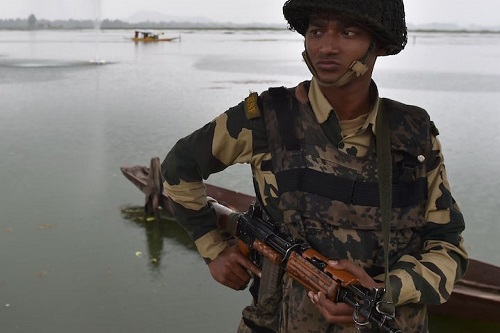AFP photo
By
Zeeshan A. Shah
Many countries in the Middle East have been fighting for resources for decades but today some of them are at war. From the Middle East to the Far East, Asia has been dominated by water wars.
The battle lines have been drawn clearly as the world enters a more deadly and decisive phase of war. Water is the new weapon of war.
A dark background indicates evidence. At the heart of the Gaza strip lays the River Jordan, where Syria, Iraq and Turkey remain in constant conflict over the shared rivers –the Tigris and Euphrates. Elsewhere in Africa, the construction of the Great Ethiopian Renaissance Dam in the Blue Nile has triggered a red alert between Egypt and Ethiopia. A full-blown water war would be catastrophic to the hundreds of millions of people in India and Pakistan depending on water.
In Yemen, over 2.6 million residents of Sana’a have been forced to leave the city due to water scarcity as war rages across the border. The Yemeni government’s estimates confirm that over 4,000 deaths take place every year over local disputes over land and water. There is civil war elsewhere as Israel strips Palestinians of all legal rights of ownership over water.
Moreover, the Indus Water Treaty between India and Pakistan sustains itself, despite two great wars but tensions mount over the construction of dams on the Indian Side of the Border that could deprive Pakistan of fresh drinking water in future years and dry out fresh water banks. India has threatened to cut back on water flowing through its rivers to arid Pakistan, a threat it has made before but now seems more determined to carry out in the wake of a suicide bomb using this as a proxy on the pretext of war, in the wake of the upcoming election in the country.
Diversion or rhetoric, a full-blown water war could be catastrophic to the hundreds of millions of people in India and Pakistan who depend on river water. Sometimes, offense is the best defense when one does not have actual evidence, so it seems in the case of India. Quick to accuse Pakistan, India seems to be on the back-foot after the current visit of the Crown Prince of KSA, which is being predicted as a diplomatic failure of the BJP government in India, when compared to PTI‘s government in Pakistan.
Under a longstanding treaty governing the use of the Indus River and its tributaries, Pakistan still controls most of the water and India may not be able to win the legal battle in the International Court of Justice, as it is a violation on the International Charter of Human Rights, anywhere in the court of law. Under the Indus Water Treaty, a World Bank-brokered agreement that goes back decades, India and Pakistan divided the rights to the enormous Indus River and its tributaries that wind across the subcontinent. Both sides have grumbled over certain provisions and rely heavily on the water flows for hydropower and agriculture.
In the book ‘The price of thirst – water scarcity and the coming chaos’, the writer cites the three big issues- the rise of extremism, privatization of water resources and water scarcity as the biggest causes of potential and current wars between nations today.
A recent UN report states that in 15 years, the world could face over 40% of water shortfall. The book also further sketches a horrifying outlook on water as the cause of previous deadly wars and their impact on human populations, breakdown of eco-systems, crop failures, collapse of industries, disease and poverty.
Potentially, we are witnessing the initial flashes of water wars. In Iraq and Syria, behind the deadly slaughter lies the rise of the Daesh (the self nominated Islamic State of Iraq) who now mark control over many dams, namely the Mosul Dam – the largest dam in Iraq that controls the majority of water resources. This has become the strategic battleground between Daesh and Kurdish Iraqi forces, leading many people to die of thirst in this war. Water shortages have contributed to the emergence of extremist groups like ISIS (Daesh) as a whiplash effect of the Gulf War since 1991.
In the Middle East, water shortage, cut offs and dam takeovers are being used as tools to manipulate and politically control governments and societies, using pressure tactics. In the case of the Mosul Dam, whoever eventually controls the dam will control the downstream flow of water and could threaten users dependant on water for survival – by floods or drought.
Events leading up to the Daesh invasion of Iraq show a deeper, clearer pattern of war.
Water was made a man-made emergency. During the American coalition-led Gulf War, water facilities were attacked by ground forces destroying infrastructure that fractured and was never repaired after that, leading to an early undetected water crisis and the rise of Daesh, a natural by-product of the American occupation of Iraq. It also exposes the long history of corruption under the US reconstruction drive that was primarily driven to acquire oil resources and deplete water reservoirs leading to the arms race in Iraq and a perpetual civil war.
Analysts have predicted that the Syrian civil war was a direct result of the intense drought of 2007 as a hidden water war continues in that region. Over 500,000 people were massacred and 15 million displaced, the past a horrible reminder of the water war that was deliberately triggered.
At the time, Turkey was promoting agricultural development near the Syrian and Kurdish borders, bringing in Turkish farmers replacing the Kurds. And Turkey s position over the GAM dams at the time further worsened the situation as irrigation on Turk borders was being ramped up while the Syrian side was shut down. Daesh exploited this eventually leading to its emergence as the new player of war. Ruthless dam building across Middle East and Asia is also leading to enormous water losses due to evaporation.
The UN has reported that by 2050, Global Water demand will increase by 55%. Rich countries may apply for desalination plants – expensive and oil intensive processes. Others will suffer the consequences of war. Saudi Arabia for example risks its own existence over the distribution of wealth, be it oil or water. Desalination is a short term strategy for survival, not an eventual solution. Saudi Arabia needs Pakistan, who in turn needs Turkey for support on the river-water crisis to broker support to avert an International War on Water. For CPEC, Pakistan needs water resources to support the immense infrastructure being built in Baluchistan and any backlash with Iran could be counter-productive. Water wars and their escalation would actually determine the peace process in future for Asia and the Middle East.
Safe drinking water is shrinking globally. With a lack of an integrated approach to water resource management, more ways need to be found before there is more climate change impact and more wars. Water conservation should be looked at from a macro perspective – not just the per capita consumption. Wasteful industrial and agricultural water usage must also be accounted for. Gender equality, low poverty rates and a cleaner greener environment is the only possible solution. Costa Rica for example, is on its way to becoming the first carbon neutral country in the world by 2021.
Ninety percent of the world’s population lives in countries that share river and lake basins and hence, must not lose sight on progress through peace. Water must be seen as a source of cooperation and not as prelude to war. In South Asia, China, India, Nepal, Pakistan and other such countries are at a high risk – fearing loss of freshwater banks and future water insecurity. An increase in flood-drought cycles may lead to further water crisis within the region.
Today, 100 liters of water per person per day is not enough. Are banks financing water projects for public utilities or for private profiteering? Are governments adopting water policies that conserve water? Is the water industry getting rich from the poor water without supplying them clean water? Pakistan for instance is yet to formally cascade a Country Water Policy.
In 1950, there were approximately 2.5 billion people; today we are 7 billion people. By 2050, the population is projected to top 9 billion. By 2050, nearly 40% of global youth will live in Asia- another 50% will live in Africa. How much water is required in future for our children? People will probably live better and longer lives. Global GDP will likely triple; natural resource consumption will double. And the effects of climate change–somehow inevitable–will be felt more strongly than they are today. Without water however, no country can ensure future growth.
In 2016, after militants attacked an Indian Army base near the town of Uri, Prime Minister Narendra Modi said “blood and water can’t flow together” and his government threatened to do the same thing. Instead, the Indian military staged what it called surgical strikes against targets just across the border in Pakistan.
This new and more aggressive threat on a water-war between India and Pakistan is on the radar.
According to a political analyst at the Middle East Institute in Washington, India’s threats were driven by national elections expected in the coming months. Yet another view from Brahma Chellaney, a professor at Center for Policy Research in New Delhi and an expert on the India-Pakistan water treaty, who said that for years India has struggled to harness waters from the rivers it controls.
The region is water-stressed. Today, there are roughly 700 million people across 43 countries living in regions with severe water scarcity. This might be the beginning of a Global Crisis that would change the fate of nations around the world. There will be water shortages wherever there is war and in places where there is severe climate change. No one knows what changes will emerge but what we do know today is that changes have already started to happen. We must prepare to identify our countries’ most precious resources before we plunge into a deeper crisis of a civil war.
Water wars will kill a lot more human populations and a new battleground is ready to take war to the next level. We may be getting a glimpse of the future of conflict in South Asia.
Zeeshan A. Shah
Zeeshan Shah writes on Global Affairs, Climate Change, Governance and Public Policy. He is a banker and a broadcaster.
The writer is a Director at CNNA Pakistan – a leading advocacy institute and is an expert on International Relations and Education Policy.
With over 150 publications in major local and global social media & newspapers, he has been instrumental in producing over 5,000 radio broadcasts aired globally.
A thought leader, environmental journalist, media broadcaster and a change maker with an acute focus on development affairs & education for Pakistan.



No Comments Yet!
You can be first to comment this post!